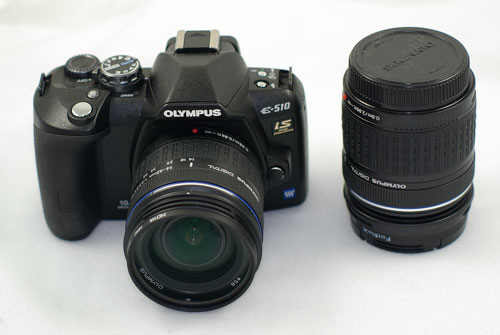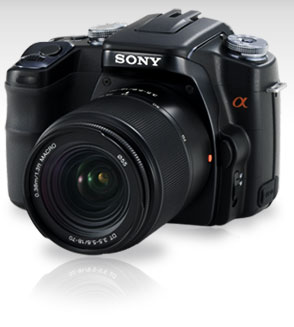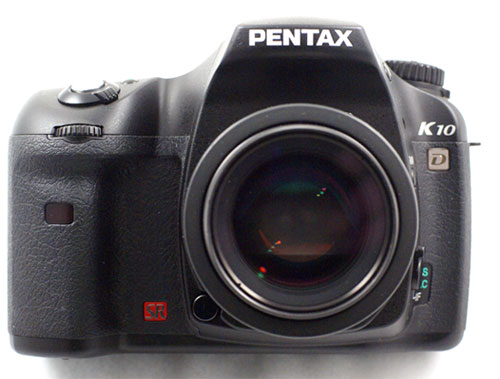Digital Camera Buyers' Guide - Year of the SLR
by Wesley Fink on November 23, 2007 6:00 AM EST- Posted in
- Digital Camera
Entry-Level Recommendations
Entry-level buyers don't normally have a collection of lenses for their new camera, so they are usually shopping for kits. Kit lenses are notorious for being mediocre, but that is improving in some of the kits we have recently seen. Our recommendations considered the quality and value of the kit itself, as well as the lens system for the entry DSLR buyers who end up enjoying digital photography and want to grow.

We are getting ready to be stoned, as our recommendation for best value in a kit is the 2-lens Olympus E-510 kit. The picture above is the complete kit, with both the 14-45mm f3.5-5.6 and tiny 40-150mm f4.0-5.6. These two small and light lenses cover the 35mm equivalent of 28mm to 300mm - a range from true wide angle to moderate telephoto. The 510 system finally realizes the promise of 4/3 with a small light body and small light lenses, but these two lenses are also two of the finest quality kit lenses available anywhere. This two-lens kit is available for as little as $675 at Amazon.com with free shipping, and you will find the E-510 two-lens kit at many web and brick-and-mortar stores for less than $800.
You get all the checklist features in this 10MP DSLR kit. This includes auto sensor cleaning and Live View as well as body integral image stabilization that works with all 4/3 lenses. This image stabilization - a first for Olympus - is selectable for either horizontal motion, which is generally best for panning and action, or both horizontal and vertical for general use, or off.
Olympus has improved their autofocus modules with each new generation, and the E-510 is the best one yet (outside of the E-3). However, the autofocus is still a weakness in an otherwise very capable system. It uses the somewhat dated 3-point autofocus, with a center cross sensor for greater sensitivity. In normal light, the E-510 is just as accurate and fast as other cameras, but it tends to search too much in low light conditions. Olympus introduced a fast and innovative 11 cross point 4-plane AF module in their new E-3. It needs to move down the line quickly to fix the last remaining issue with Olympus DSLR cameras. However, your reward with the E-510 is gorgeous, sharp, and evenly lighted lenses with the two kit lenses - and that is what photography is about.


Alternative: If low-light performance is a major concern, then you would do well to choose the Sony A100 kit with the 18-70mm kit lens. For a bit more money, the Pentax K10D gives you a great 11-point auto focus module, the truly useful hyperprogram feature that allows front and back dials to shift aperture and shutter speed in equivalent program steps, 3-plane image stabilization, all the other features, PLUS pro-type dust and moisture sealing.
The Safe Choice: The safe choice, and the one most buyers will make, is the Canon Rebel XTi or the Nikon D40x with the pedestrian 18-55mm kit lens. The problem with either choice is they don't include image stabilization, which is most useful with the slow kit lenses most camera makers sell with their entry cameras. In their favor, Canon includes auto sensor cleaning, but Nikon doesn't even bother with that. Nikon does provide a bit better image quality with their 18-55mm, so that makes it something of a toss-up.
It appears both Nikon and Canon are being hurt somewhat by their lack of mechanical image stabilization since they have both announced the availability of their basic kit lens with optical image stabilization. Yes, you will be seeing these IS and VR versions of the 18-55mm in future Canon and Nikon kits. There are arguments that can be made for optical IS instead of the mechanical body-integral IS that works with all lenses. However, the thought of spending more for the Canon 18-55mm with IS is difficult to stomach. What these announcements really say is Canon and Nikon are still resisting IS as a standard feature, though they are addressing this as a checklist item with IS/VR versions of their entry kit lens.










74 Comments
View All Comments
Johnmcl7 - Saturday, November 24, 2007 - link
The Digilux 3 is the Leica branded version of the Panasonic DMC-L1 and they're both relatively hefty cameras when compared to the smaller E-410/E-510 cameras or even their Olympus sibling the E-330. Although not anywhere near as big as something like the 5D, the Digilux 3 is bigger than the E-510.The Digilux 2 was a smaller camera (Leica version of the Panasonic LC-1) which may be the one you're thinking of although this wasn't an SLR despite the similarity in design to the L1/Digilux 3.
Also, the E-3 doesn't have a lens cleaning feature:
"The E-3 is also the first Olympus pro model to feature built-in flash, and it's dust and splash sealed. Auto lens cleaning is a feature, image stabilization is built in and works with all lenses, and the latest incarnation of Live View with a fold out articulating LCD screen is featured."
I assume you're referring to the sensor cleaning feature?
John
Johnmcl7 - Saturday, November 24, 2007 - link
The Digilux 3 is the Leica branded version of the Panasonic DMC-L1 and they're both relatively hefty cameras when compared to the smaller E-410/E-510 cameras or even their Olympus sibling the E-330. Although not anywhere near as big as something like the 5D, the Digilux 3 is bigger than the E-510.The Digilux 2 was a smaller camera (Leica version of the Panasonic LC-1) which may be the one you're thinking of although this wasn't an SLR despite the similarity in design to the L1/Digilux 3
John
Johnmcl7 - Saturday, November 24, 2007 - link
The Digilux 3 is the Leica branded version of the Panasonic DMC-L1 and they're both relatively hefty cameras when compared to the smaller E-410/E-510 cameras or even their Olympus sibling the E-330. Although not anywhere near as big as something like the 5D, the Digilux 3 is bigger than the E-510.The Digilux 2 was a smaller camera (Leica version of the Panasonic LC-1) which may be the one you're thinking of although this wasn't an SLR despite the similarity in design to the L1/Digilux 3
John
Johnmcl7 - Saturday, November 24, 2007 - link
The Digilux 3 is the Leica branded version of the Panasonic DMC-L1 and they're both relatively hefty cameras when compared to the smaller E-410/E-510 cameras or even their Olympus sibling the E-330. Although not anywhere near as big as something like the 5D, the Digilux 3 is bigger than the E-510.The Digilux 2 was a smaller camera (Leica version of the Panasonic LC-1) which may be the one you're thinking of although this wasn't an SLR despite the similarity in design to the L1/Digilux 3
John
Johnmcl7 - Saturday, November 24, 2007 - link
The Digilux 3 is the Leica branded version of the Panasonic DMC-L1 and they're both relatively hefty cameras when compared to the smaller E-410/E-510 cameras or even their Olympus sibling the E-330. Although not anywhere near as big as something like the 5D, the Digilux 3 is bigger than the E-510.The Digilux 2 was a smaller camera (Leica version of the Panasonic LC-1) which may be the one you're thinking of although this wasn't an SLR despite the similarity in design to the L1/Digilux 3
John
Johnmcl7 - Saturday, November 24, 2007 - link
The Digilux 3 is the Leica branded version of the Panasonic DMC-L1 and they're both relatively hefty cameras when compared to the smaller E-410/E-510 cameras or even their Olympus sibling the E-330. Although not anywhere near as big as something like the 5D, the Digilux 3 is bigger than the E-510.The Digilux 2 was a smaller camera (Leica version of the Panasonic LC-1) which may be the one you're thinking of although this wasn't an SLR despite the similarity in design to the L1/Digilux 3
John
Johnmcl7 - Saturday, November 24, 2007 - link
The Digilux 3 is the Leica branded version of the Panasonic DMC-L1 and they're both relatively hefty cameras when compared to the smaller E-410/E-510 cameras or even their Olympus sibling the E-330. Although not anywhere near as big as something like the 5D, the Digilux 3 is bigger than the E-510.The Digilux 2 was a smaller camera (Leica version of the Panasonic LC-1) which may be the one you're thinking of although this wasn't an SLR despite the similarity in design to the L1/Digilux 3
John
Johnmcl7 - Saturday, November 24, 2007 - link
The Digilux 3 is the Leica branded version of the Panasonic DMC-L1 and they're both relatively hefty cameras when compared to the smaller E-410/E-510 cameras or even their Olympus sibling the E-330. Although not anywhere near as big as something like the 5D, the Digilux 3 is bigger than the E-510.The Digilux 2 was a smaller camera (Leica version of the Panasonic LC-1) which may be the one you're thinking of although this wasn't an SLR despite the similarity in design to the L1/Digilux 3
John
smmorrison - Saturday, November 24, 2007 - link
This isn't a bad buying guide and certainly better than wired magazines recent guide which was horrible.My main concern(and I am a photography teacher) is that these guides don't ever really take into account one of the primary reasons for buying a DSLR...the lenses & accessories. There are many reasons why most pros or semi pros choose nikon or canon(and I am a canon guy myself). They have lenses and accessories for everything. Need a macro lens, got it, need a tilt shift...got it...super tele for birdwatching or sports...got it...super low light prime...got it. And I think sports will be a main reason for many families buying DSLR's. Nikon and Canon are far superior for shooting sports. There are 3rd party alternatives for many other brands, but they often are not as good as the manufacturers lenses or have issues with focusing or compatibility(sigma is well known for this). Then there are the accessories...off camera flashes, macro flashes, off camera cords, battery grips...the list goes on. Some of the other brands might have some of these as well...but at some point, if a photographer progresses they will likely reach a point where sony or olympus or even pentax doesnt have the lens or accessory for what they want to do. Might not happen, but if you get really into the hobby it probably will. There is also the factor of the used lens market...It is far easier to find used lenses for Nikon and Canon on ebay, FredMiranda, B&H, etc.
I also fully agree with some of the above comments about image quality. These are DSLR's NOT point and shoots...I think people have gotten obsessed with features with point and shoot cameras, but with DSLR's its about the image quality...and what these articles frequently forget is that the image quality often comes down to the glass. You are really buying a lens system, not a body...Megapixels, in camera stabilization, and sensor cleaning really are not that big a deal.
The only '3nd tier' brand that would be interesting is Pentax, since you can use their older lenses...a big factor, since many of the older primes are great lenses and can be bought cheap. I would never recommend Sony or Olympus to students or friends.
If magazines and websites are going to start talking about DSLR's, they need to not focus on the bodies so much and start seriously talking about the lenses and recognize that Canon and Nikon are on top for a reason...they have everything you will ever need for your camera.
just my .02
Wesley Fink - Saturday, November 24, 2007 - link
Actually we chose the Olympus E-510 2-lens kit BECAUSE of the superior imaging quality of the kit lenses. Both kit lenses, which cover the 35mm equivalent of 28mm to 300 mm are far better in image quality than either Canon or Nikon kit lenses. Check out other review sites and you will see many other sites agree the Olympus kit lenses are better quality than the competition and that Olympus 4/3 lenses in general provide better image quality than competing lenses on APS-C cameries.Do we ignore image quality and select Canon or Nikon because they are better known in DSLR? We agree and stated that Canon or Nikon are the safe choices, but thy are not necessarily the best quality in digital imaging.